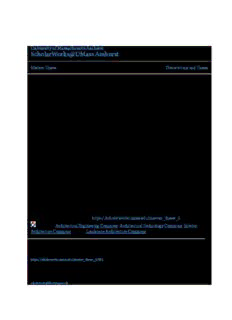
renovating the fort river elementary school in amherst, ma PDF
Preview renovating the fort river elementary school in amherst, ma
UUnniivveerrssiittyy ooff MMaassssaacchhuusseettttss AAmmhheerrsstt SScchhoollaarrWWoorrkkss@@UUMMaassss AAmmhheerrsstt Masters Theses Dissertations and Theses July 2018 TTHHEE EENNHHAANNCCEEMMEENNTT OOFF LLEEAARRNNIINNGG TTHHRROOUUGGHH TTHHEE DDEESSIIGGNN PPRROOCCCCEESSSS:: RREENNOOVVAATTIINNGG TTHHEE FFOORRTT RRIIVVEERR EELLEEMMEENNTTAARRYY SSCCHHOOOOLL IINN AAMMHHEERRSSTT,, MMAA Reyhaneh Bassamtabar University of Massachusetts Amherst Follow this and additional works at: https://scholarworks.umass.edu/masters_theses_2 Part of the Architectural Engineering Commons, Architectural Technology Commons, Interior Architecture Commons, and the Landscape Architecture Commons RReeccoommmmeennddeedd CCiittaattiioonn Bassamtabar, Reyhaneh, "THE ENHANCEMENT OF LEARNING THROUGH THE DESIGN PROCCESS: RENOVATING THE FORT RIVER ELEMENTARY SCHOOL IN AMHERST, MA" (2018). Masters Theses. 683. https://doi.org/10.7275/12206368 https://scholarworks.umass.edu/masters_theses_2/683 This Open Access Thesis is brought to you for free and open access by the Dissertations and Theses at ScholarWorks@UMass Amherst. It has been accepted for inclusion in Masters Theses by an authorized administrator of ScholarWorks@UMass Amherst. For more information, please contact [email protected]. THE ENHANCEMENT OF LEARNING THROUGH THE DESIGN PROCCESS: RENOVATING THE FORT RIVER ELEMENTARY SCHOOL IN AMHERST, MA A Thesis Presented by REYHANEH BASSAMTABAR Submitted to the Graduate School of the University of Massachusetts Amherst in partial fulfilment of the requirements for the degree of MASTER OF ARCHITECTURE May 2018 Department of Architecture © by Reyhanehsadat Bassamtabar 2018 All Rights Reserved ENHANCEMENT OF LEARNING THROUGH THE DESIGN PROCCESS FOR SCHOOLS: RENOVATING THE FORT RIVER ELEMENTARY SCHOOL IN AMHERST, MA A Thesis Presented by REYHANEH BASSAMTABAR Approved as to style and content by: _____________________________________ Ray K Mann, Chair _____________________________________ Naomi Darling, Member _____________________________________ Professor Stephen Schreiber, Chair, Department of Architecture DEDICATION To my family and Mr. Mohammad Babaee For their advice, their patience, and their faith. Specially to Mr. Babaee, I could not imagine it without him. ACKNOWLEDGEMENTS I would like to acknowledge my academic advisors for their role in the development and success of this project. First, I would like to thank Ray Mann, the Chair of this research project, whose extensive experience and knowledge of architecture from Asia has been an invaluable resource, offering both richness of design and courageousness of spirit. Ray was very patient and supportive in the most challenging year of my life, she reminded me of my love for flow, movement, and their impacts on our wellbeing. I want to also thank my faculty advisors from the Architecture and Design Department at UMass: Naomi Darling, the Member of this research project, whose attention to detail propelled this project forward; and Caryn Brause, who led me to be a professional person. I want to pay tribute to Mr. Mohammad Babaee, who sculpted my understanding of what the healthy life is and how to explore it. He supported my education by encouraging me to observe my surrounding scientifically even when we are looking at the background and history of art and architecture, to learn about our spirit. I wish to express my appreciation to my friends and family who have been a continuous source of patience, strength and inspiration throughout the past two and half years of this graduate program. A special thank you to Kuhn Riddle Architects, a talented and creative group of designers, a place where learning a tiny task was the biggest relief because it was elevated from the ocean of shared experiences. v ABSTRACT THE ENHANCEMENT OF LEARNING THROUGH THE DESIGN PROCCESS: RENOVATING THE FORT RIVER ELEMENTARY SCHOOL IN AMHERST, MA MAY 2018 REYHANEH BASSAMTABAR, M.ARCH, UNIVERSITY OF MASSACHUSETTS AMHERST Directed by: Professor Ray K Mann The purpose of my thesis is to discover a logical way to connect the ideas of Rudolf Steiner, developer of the Waldorf Education Method, and current theories of educational and psychology with the architectural design of an educational facility while maintaining Massachusetts Department of Education standards. With this purpose in mind, I studied a school, built in 1973 in Amherst: the Fort River Elementary School. The current school structure is in architectural conflict with many of the ideas extolled by the Waldorf Method. Among the questions I wish to address in my thesis are: “What is the role of architecture in enhancing the quality of education?”, “What are the design elements which inspire learning?” “Can a Waldorf Method based design be compliant with Massachusetts Standards?” vi TABLE OF CONTENTS Page ACKNOWLEDGEMENTS ........................................................................................................... v ABSTRACT ................................................................................................................................ vi LIST OF TABLES ....................................................................................................................... ix LIST OF FIGURES ..................................................................................................................... x CHAPTER 1- THESIS INTENT: ADAPTIVE RE-USE .................................................................................. 1 Introduction: Fort River Elementary School............................................................................ 1 2- IDEAS OF SCHOOL ENVIRONMENTS ................................................................................. 7 Historical Development of American School Architecture ....................................................... 7 The Waldorf Education ..........................................................................................................10 Rudolf Steiner’s Educational System .................................................................................11 Child Development .............................................................................................................12 Waldorf's special Architecture? ..........................................................................................15 The Montessori System .........................................................................................................19 Movement Enhances Learning ...........................................................................................19 The Montessori Education .................................................................................................20 The Physiology of Learning ...................................................................................................22 The Psychology of learning: ..................................................................................................25 Types of Threats ................................................................................................................26 Biophilic Design for schools: ..................................................................................................27 3- PRECEDENT STUDIES .......................................................................................................29 Waldorf Schools ....................................................................................................................29 Indian Community School of Milwaukee Franklin, Wisconsin .................................................32 The Farming Kindergarten – Architects: Vo Trong Nghla .......................................................36 Architectural Senses ..............................................................................................................41 Biophilic Design for Schools ..................................................................................................44 The Montessori Schools ........................................................................................................46 Montessori School Design .................................................................................................46 Amherst Montessori ...........................................................................................................47 Marl School - Hans Scharoun -1971 ..................................................................................48 The Montessori School - Herman Hertzberger ...................................................................50 4- DESIGN PROCCESS……………………………………………………………………………….51 vii Project Site ............................................................................................................................51 Site Analysis ..........................................................................................................................60 Program Analysis ..................................................................................................................60 ARCHITECTURAL CRITERIA IN SCHOOL DESIGNING ......................................................63 Review the Principles to Increase the Architectural Quality of Schools ..................................64 Axis ....................................................................................................................................64 Repetition...........................................................................................................................64 Symmetry...........................................................................................................................64 Hierarchy ...........................................................................................................................65 Rhythm ..............................................................................................................................65 Review the Physical Influences in the design of Schools .......................................................66 Form ..................................................................................................................................66 Light: ..................................................................................................................................66 Temperature ......................................................................................................................66 Sound: ...............................................................................................................................66 Air quality: ..........................................................................................................................66 RENOVATION OR BUILDING NEW?....................................................................................67 DESIGN PROCCESS ............................................................................................................71 KEY ELEMENTS ...................................................................................................................82 APPENDICES ...........................................................................................................................83 A. PRESENTATION BOARDS ..............................................................................................84 B. MEMORANDUM-NOT HUMAN SUBJECT RESEARCH DETERMINATION .....................91 REFERENCES .........................................................................................................................92 viii LIST OF TABLES Table Page 1: Human Qualities & Architecture Senses ................................................................................41 2: Program Analysis ..................................................................................................................62 ix
Description: